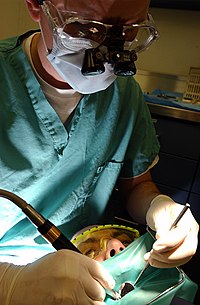
Photo from wikipedia
AIM The purpose of this study was to evaluate the periapical status of endodontically treated teeth and the integrity of endodontic treatment before and after orthodontic treatment. MATERIALS AND METHODS… Click to show full abstract
AIM The purpose of this study was to evaluate the periapical status of endodontically treated teeth and the integrity of endodontic treatment before and after orthodontic treatment. MATERIALS AND METHODS This retrospective study was conducted by evaluating 128 teeth with root canal treatment (RCT). The teeth were obtained from 72 patients (23 males, 49 females) who had undergone fixed orthodontic treatment. Panoramic radiographs were taken and were evaluated before the start and after the completion of orthodontic treatment. Apical periodontitis (AP) was evaluated by the periapical index (PAI) and the probability index (PRI) of periapical bone destruction. Other variables related to the quality of root canal fillings were included, such as RCT quality index, length, and homogeneity, and coronal restoration. RESULTS According to the PRI, the proportion of teeth with periapical bone destruction was significantly higher after orthodontic treatment. Overall, there was no significant change in the PAI scores after orthodontic treatment. However, the quality of the endodontic treatment moderated the change in the PAI score, as well as the change in the PRI. There was no significant increase in PAI and PRI scores after orthodontic treatment for adequately treated teeth. However, the risk for periapical lesions and bone destruction after orthodontic treatment was significantly increased for teeth receiving inadequate endodontic treatment compared with those receiving adequate endodontic treatment. CONCLUSION Increased PAI and PRI after orthodontic treatment correlated with the quality of endodontic treatment.
Journal Title: European journal of orthodontics
Year Published: 2019
Link to full text (if available)
Share on Social Media: Sign Up to like & get
recommendations!